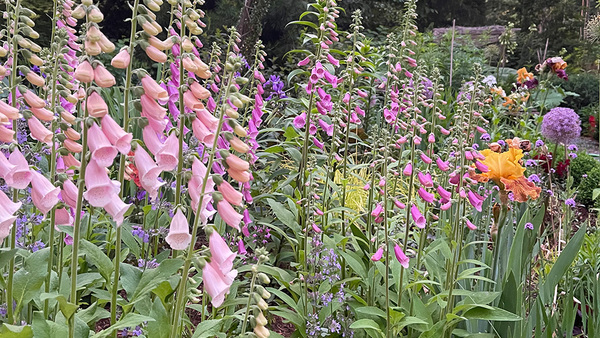
I don’t know about you, but once winter arrives here in the Northeast and the leaves have fallen off all of the trees, my eyes focus on things I just never noticed in the summer. Winter is when I can’t help but see both eyesores and lots of garden design opportunities. Here are five things you can do as you look over your Northeastern garden this winter.
Learn more: Northeast: February Garden To-Do List

Identify gaps
Once the leaves drop and perennials die back, bare trees and borders reveal how much real estate one really has. In winter, I am reminded of places, often in understories, where I should add more plants that bloom in late winter and early spring. Sure, there are always opportunities for spring bulbs, but let’s not forget that there are plenty of opportunities for shade-loving perennials under small trees and shrubs. Winter is the time to think about areas where woodland ephemerals, hellebores (Helleborus spp. and cvs., Zones 4–9), and even epimediums (Epimedium spp. and cvs., Zones 4–9) can shine before the leaves on the trees unfurl and the summer garden steals attention away again.

Evaluate sight lines
Don’t get me wrong—I love my neighbors. But winter is a great time to consider where to plant shrubs and trees to hide their new aboveground swimming pool or shed. Even a misplaced telephone pole can be an eyesore. These things can be camouflaged rather quickly in just a few years with strategic placement of a quick-growing tree such as birch (Betula spp. and cvs., Zones 2–9) or tupelo (Nyssa spp. and cvs., Zones 3–9).

Consider hedging
While there is nothing wrong with planting a hedge purely for tactical reasons, like marking a property boundary or hiding a dumpster, it’s OK to plant one simply for the birds. Irruptions of Northern winter finches like grosbeaks, as well as crossbills and cedar waxwings, will thank you for offering them a hedge full of berries. Additionally, a lightly trimmed hedge of red winterberry (Ilex verticillata, Zones 3–9) or crabapple (Malus spp. and cvs., Zones 2–8) provides color and interest. Viburnums (Viburnum spp. and cvs., Zones 3–9) are rarely used in hedging but make good candidates for hedging. If you are looking for an evergreen holly, try hybrid Meserve holly (Ilex × meserveae, Zones 4–8) for an unusual yet effective winter show.

Dare to go bare
I know I am not alone in appreciating the bare, gray branches of a well-trimmed deciduous tree or shrub. My pleached hornbeam hedges (Carpinus spp. and cvs., Zones 3–9) stop traffic mostly in winter, which is why I keep planting them around our property. Popular in Britain, deciduous hornbeam (or beech) hedges are beginning to find an audience in North America. Easy to care for and inexpensive if planted as saplings 3 feet apart, these quick-growing hedges only require a trim in June and once again in autumn to retain their beauty and form. For other deciduous trees and shrubs with winter interest, consider privet (Ligustrum spp. and cvs., Zones 3–10), which you will have to trim biannually. I also think that shrubs with nice natural branching (that are never trimmed into a hedge) and with gorgeous buds are particularly nice, such as fothergilla (Fothergilla spp. and cvs., Zones 4–9) or Japanese stewartia (Stewartia pseudocamellia, Zones 5–8). Japanese kerria (Kerria japonica, Zones 4–9) is another great choice, with gorgeous, bright spring-green stems that look good against white snow. For more shrubs with great winter bark, read on here: Intriguing Bark Enlivens a Winter Scene. And for more winter-blooming shrubs, read on here: Six Winter-Blooming Shrubs for the Northeast.

Go beyond ever-green
Modern gardeners are fortunate to have access to many evergreens that offer a broad range of colors beyond green. Korean firs (Abies koreana, Zones 5–7) offer fabulous upright bluish-violet cones that make my heart race every time I see them, and most yellow-needled conifers look their best set against white snow and winter sunlight. A favorite of mine is the ‘Skylands’ Oriental spruce (Picea orientalis ‘Skylands’, Zones 4–7), with its bright, golden needles and uniform shape that keeps getting better and better with each winter. Consider adding a “beyond-green” evergreen this coming year. For more unusual conifers, read on here:
—Matt Mattus is a lifelong gardener and vice president of the Worcester County Horticultural Society. He has written two books: Mastering the Art of Flower Gardening and Mastering the Art of Vegetable Gardening.
Fine Gardening Recommended Products

VegTrug Classic Cold Frame
Fine Gardening receives a commission for items purchased through links on this site, including Amazon Associates and other affiliate advertising programs.

ARS Telescoping Long Reach Pruner
Fine Gardening receives a commission for items purchased through links on this site, including Amazon Associates and other affiliate advertising programs.

Attracting Beneficial Bugs to Your Garden, Revised and Updated Second Edition: A Natural Approach to Pest Control
Fine Gardening receives a commission for items purchased through links on this site, including Amazon Associates and other affiliate advertising programs.



















Comments
Log in or create an account to post a comment.
Sign up Log in